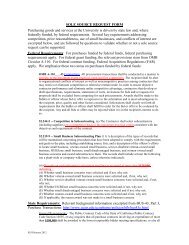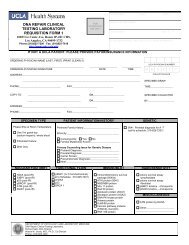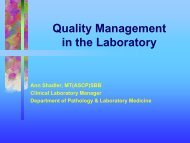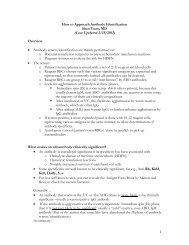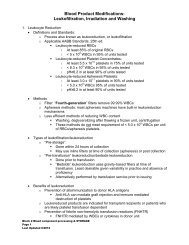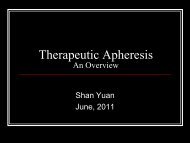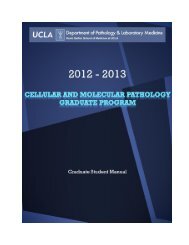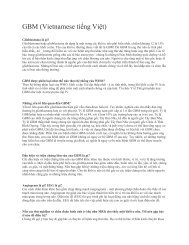TRANSFUSION MEDICINE - the UCLA Department of Pathology ...
TRANSFUSION MEDICINE - the UCLA Department of Pathology ...
TRANSFUSION MEDICINE - the UCLA Department of Pathology ...
You also want an ePaper? Increase the reach of your titles
YUMPU automatically turns print PDFs into web optimized ePapers that Google loves.
een proven. 5 There are some anecdotal reports <strong>of</strong> successful treatment <strong>of</strong> refractoryDIIHA with plasmapheresis. 10Drug-Induced Immune Thrombocytopenia (DIIT)Background and PathophysiologyIn addition to hemolytic anemia, drugs can cause thrombocytopenia throughsimilar immune-mediated processes. Heparin-induced thrombocytopenia is <strong>the</strong>most common and well described <strong>of</strong> <strong>the</strong>se entities and is caused by antibodies withspecificity to complexes <strong>of</strong> platelet factor 4 and heparin. This results in moderatethrombocytopenia 5 to 14 days after treatment. Bleeding is uncommon, butthrombosis occurs in more than one half <strong>of</strong> patients. 11 DIIT due to o<strong>the</strong>r drugs is rareand is associated with more severe thrombocytopenia and increased risk <strong>of</strong> bleeding.The incidence <strong>of</strong> DIIT is estimated at 10 persons per million per year, thoughthis is likely an underestimate. 12 The data <strong>of</strong> George and colleagues, who reviewedcases <strong>of</strong> DIIT reported through 2008, is available online: http://www.ouhsc.edu/platelets. According to <strong>the</strong>ir criteria (explained in detail at <strong>the</strong> website), 51 drugs aredefinite and 17 o<strong>the</strong>rs are probable causes <strong>of</strong> DIIT. Based on <strong>the</strong>ir analysis, DIITis most commonly associated with quinine and sulfonamide antibiotics. Quinidine,nonsteroidal anti-inflammatory drugs, rifampin, vancomycin, anticonvulsants, goldsalts, antineoplastics (fludarabine, oxaliplatin), and platelet inhibitors (tir<strong>of</strong>iban,eptifibatide, and abciximab) are also implicated. 12transfusion medicineTM 11-4© ASCP 2011DIIT is most commonlyassociated with quinineand sulfonamideantibiotics.Several pathophysiologic mechanisms have been proposed. An early model suggestedthat drugs bind covalently to platelet membrane proteins and act as haptens to induceformation <strong>of</strong> drug-dependent antibodies in a process analogous to DIIHA causedby high-dose penicillin. This may account for <strong>the</strong> rare cases <strong>of</strong> thrombocytopeniacaused by penicillin, piperacillin, and cephalosporins, but does not explain DIITcaused by o<strong>the</strong>r drugs. 12 For more than 20 years, <strong>the</strong> major hypo<strong>the</strong>sis was <strong>the</strong>“immune complex” mechanism, which proposed that some drugs can react directlywith antibodies to produce immune complexes that target platelets for destruction.However, <strong>the</strong>se complexes have never been demonstrated experimentally, and thishypo<strong>the</strong>sis has since fallen out <strong>of</strong> favor. 12 A newer model suggests that drug-dependentantibodies are probably derived from naturally occurring autoantibodies with weakaffinity for platelet membrane glycoproteins. The presence <strong>of</strong> certain drugs improves<strong>the</strong> binding <strong>of</strong> <strong>the</strong> antibody to <strong>the</strong> platelet membrane glycoprotein (GP; typicallyGPIIb-IIIa or GPIb-V-IX). Examples <strong>of</strong> such drugs include quinine, sulfonamideantibiotics, nonsteroidal anti-inflammatory drugs, and anticonvulsants. 12Some drugs induce formation <strong>of</strong> true autoantibodies that can bind directly to plateletsin a drug-independent manner. One to 2% <strong>of</strong> patients treated with gold salts developplatelet autoantibodies. 12,13 Autoantibodies can also arise in response to L-dopa,procainamide, penicillamine, interferon α and β, and occasionally sulfonamideantibiotics. 12,13 This form <strong>of</strong> DIIT is clinically indistinguishable from idiopathicthrombocytopenic purpura and is diagnosed on clinical grounds.Several novel DIIT mechanisms have been described and are worth noting. Fibansare a class <strong>of</strong> platelet inhibitor drugs that includes tir<strong>of</strong>iban and eptifibatide. Theywork by binding to <strong>the</strong> recognition site on GPIIb-IIIa, preventing its interaction47





